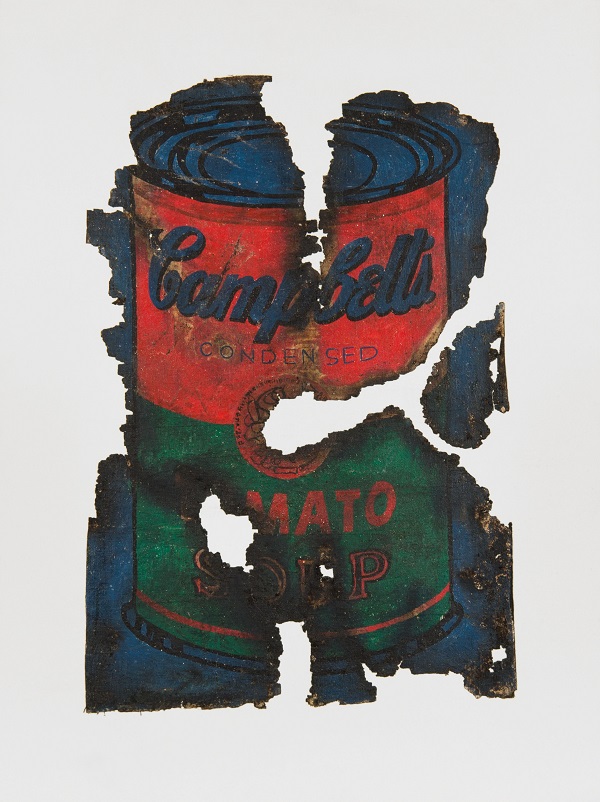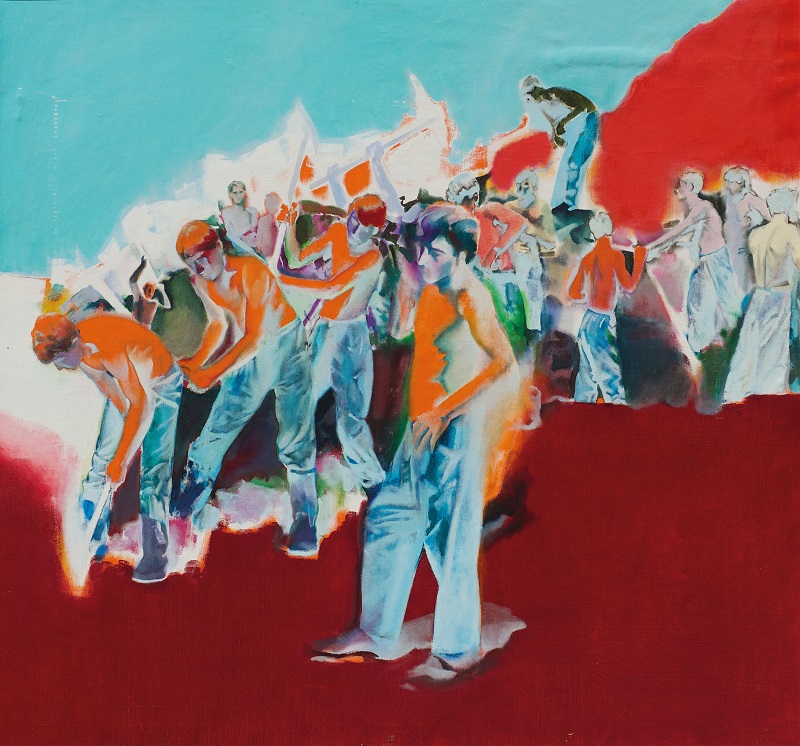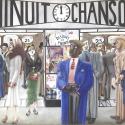There’s no sign of Oldenburg, Warhol or Lichtenstein and British pioneers Eduardo Paolozzi and Peter Blake are notably absent from this gritty vision of Pop art. Only in the final room do we come face-to-face with a Campbell’s Tomato Soup tin, the comforting bright colours and clean, supermarket-aisle lines blackened, singed and fragmented as if salvaged from some unimaginable disaster. Made by Russian duo Komar and Melamid in response to the state-sanctioned destruction of their 1974 self-portraits as Stalin and Lenin, this unaccountably shocking image is one of a series of paintings presenting well-known pieces of American art as if discovered in the midst of a nuclear winter.
The story goes that when in 1976 Warhol saw the wreckage of his soup tin, he turned as green as a dollar bill, but surely he was mistaken when he interpreted the piece as an unalloyed personal affront. Instead, it reverberates with the political tensions of the time, and stands both as an attack on American cultural imperialism and on the censorship practised by the Russian state. And it echoes what Vitaly Komar has called the “grey ghosts”, the grainy black-and-white images of Western consumer culture that made their way behind the Iron Curtain via newspapers and magazines. But much as the image is steeped in the global politics of the Cold War, it can just as easily be read as a more rarefied, self-contained commentary on art itself, speculating on the ultimate fate, and worth, of all works of art, even those as – by now they were – canonical as Warhol’s soup tins. (Pictured below right: Komar and Melamid, Post Art No. 1 (Warhol), 1973)
 Indeed, there can be few movements in art where the supporting narrative has been constructed quite so rapidly and with such assurance, and it is one of the ironies of Pop that its appropriation of the appealing images and slogans of advertising and popular culture enabled its own commercial success. Alternative pops – made by women, carrying a political message or opposing American culture – were quickly sidelined in a narrative made official by galleries and in a series of influential publications.
Indeed, there can be few movements in art where the supporting narrative has been constructed quite so rapidly and with such assurance, and it is one of the ironies of Pop that its appropriation of the appealing images and slogans of advertising and popular culture enabled its own commercial success. Alternative pops – made by women, carrying a political message or opposing American culture – were quickly sidelined in a narrative made official by galleries and in a series of influential publications.
Even as early as the mid-Sixties a heavily edited version of Pop emerged that was white, male and American, mildly ambivalent towards the popular culture it appropriated, but ultimately revelling in its ability to antagonise the establishment’s fine art sensibilities through its celebration of surface and its indifference to the sort of intellectual underpinning that had characterised Abstract Expressionism.
If mainstream, canonical Pop is often characterised by a petulant refusal to stand wholeheartedly for anything, the examples now filling Tate Modern’s galleries are, by contrast, united by a campaigning zeal that exploits the immediacy and impact of Pop art, qualities that make it amenable to political propaganda. Conventions of mass communication readily lend themselves to more subversive messages, and this politicised Pop makes an interesting counterpoint to Socialist Realism, the style initially associated with official art of the Soviet Union that subsequently spread throughout the communist world. Hungarian artist Cornel Brudascu highlights the formal similarities between Socialist Realism and western commercial imagery by rendering Youth on the Building Yard, 1970, in bright, sugary colours (Pictured below left). By appropriating the aesthetic of the comic strip, this piece of Communist propaganda is turned back on itself to undermine its own pro-regime message.
At a time when we tend to think of the Communist Bloc as having been effectively sealed off from the West, Brudascu’s work suggests that on the contrary, Western popular culture was reasonably accessible, allowing these countries a taste of a burgeoning Western youth culture.
 While the adoption of a Pop art style could have a startlingly subversive effect, it is often American culture itself that is the enemy, its own imagery redeployed to expose a vacuous disengagement at its core. Bernard Rancillac’s At Last, a Silhouette Slimmed to the Waist, 1966, shows comic-strip US soldiers immersing a Vietnamese prisoner in boiling water while an advert for underwear runs along the top, the female models that seem to hang from the upper edge of the painting strangely echoing the upended prisoner, but otherwise utterly disengaged from the torture scene beneath them. There is no hierarchy of images here and the canvas can be hung either way up; like the sometimes distasteful juxtapositions of advertising and news in the media, torture scene and bra advert are given equal weight, and consequently none at all.
While the adoption of a Pop art style could have a startlingly subversive effect, it is often American culture itself that is the enemy, its own imagery redeployed to expose a vacuous disengagement at its core. Bernard Rancillac’s At Last, a Silhouette Slimmed to the Waist, 1966, shows comic-strip US soldiers immersing a Vietnamese prisoner in boiling water while an advert for underwear runs along the top, the female models that seem to hang from the upper edge of the painting strangely echoing the upended prisoner, but otherwise utterly disengaged from the torture scene beneath them. There is no hierarchy of images here and the canvas can be hung either way up; like the sometimes distasteful juxtapositions of advertising and news in the media, torture scene and bra advert are given equal weight, and consequently none at all.
The Vietnam war provided a rich seam of material with which to both criticise and lampoon America, and while America cast itself as the land of the free, an artist like Erró suggests that irrational fears concocted by the media, amounted to a form of mind-control every bit as pernicious as that practised by totalitarian states. In American Interior No. 1, 1968, comic-book Maoist troops gather outside the window of a peaceful suburban home (main picture), while elsewhere in the series, Vietnamese intruders have already gained access to the house.
When not the focus of anxieties about “Reds under the bed”, the domestic realm was also the site, both actual and metaphorical, for the increasingly heated gender wars of the mid-century. Women, objectified and consumed, like pieces of meat on a barbecue in Maria Pinińska-Bereś’ Love Machine, 1969, or, as in Nicola L’s Little TV Woman, 1969, reduced to part piece of furniture, part computerised blow-up doll, are sometimes vengeful, sometimes victims, an array of popular imagery either featuring or aimed at women providing a rich resource for artists to mine. And much as this exhibition will rightly go down as a landmark for rewriting the history of Pop art, it is surely just as significant for recognising a whole host of female artists from the Sixties and Seventies.





![SEX MONEY RACE RELIGION [2016] by Gilbert and George. Installation shot of Gilbert & George 21ST CENTURY PICTURES Hayward Gallery](/sites/default/files/styles/thumbnail_125_x_125_/public/mastimages/Gilbert%20%26%20George_%2021ST%20CENTURY%20PICTURES.%20SEX%20MONEY%20RACE%20RELIGION%20%5B2016%5D.%20Photo_%20Mark%20Blower.%20Courtesy%20of%20the%20Gilbert%20%26%20George%20and%20the%20Hayward%20Gallery._0.jpg?itok=3oW-Y84i)









Add comment